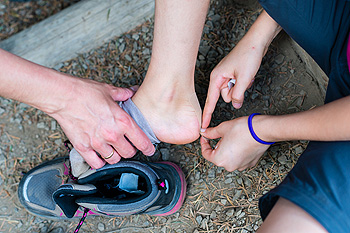
 When you increase the amount of friction on the foot, you also increase the risk of getting blisters. Blisters can originate from many sources, including socks, sweat, shoes and restricted foot motion. It’s important to have adequate toe room in the shoe; this can lessen friction, therefore preventing blisters. When proper insoles are worn, fewer blisters may occur. Additionally, wearing the correct socks, such as synthetic or wool socks, can be important in reducing skin friction. Sweat can also be a factor in producing blisters and typically happens in the warmer months. Using an antiperspirant may aid in producing less sweat, and fewer blisters may occur.
When you increase the amount of friction on the foot, you also increase the risk of getting blisters. Blisters can originate from many sources, including socks, sweat, shoes and restricted foot motion. It’s important to have adequate toe room in the shoe; this can lessen friction, therefore preventing blisters. When proper insoles are worn, fewer blisters may occur. Additionally, wearing the correct socks, such as synthetic or wool socks, can be important in reducing skin friction. Sweat can also be a factor in producing blisters and typically happens in the warmer months. Using an antiperspirant may aid in producing less sweat, and fewer blisters may occur.
Blisters are prone to making everyday activities extremely uncomfortable. If your feet are hurting, contact Dr. Harris L. Klear of Burlington County Podiatry Associates. Our doctor can provide the care you need to keep you pain-free and on your feet.
Foot Blisters
Foot blisters develop as a result of constantly wearing tight or ill-fitting footwear. This happens due to the constant rubbing from the shoe, which can often lead to pain.
What Are Foot Blisters?
A foot blister is a small fluid-filled pocket that forms on the upper-most layer of the skin. Blisters are filled with clear fluid and can lead to blood drainage or pus if the area becomes infected.
How Do Blisters Form?
Blisters on the feet are often the result of constant friction of skin and material, usually by shoe rubbing. Walking in sandals, boots, or shoes that don’t fit properly for long periods of time can result in a blister. Having consistent foot moisture and humidity can easily lead to blister formation.
Prevention & Treatment
It is important to properly care for the affected area in order to prevent infection and ease the pain. Do not lance the blister and use a Band-Aid to provide pain relief. Also, be sure to keep your feet dry and wear proper fitting shoes. If you see blood or pus in a blister, seek assistance from a podiatrist.
If you have any questions, please feel free to contact one of our offices located in Marlton and Delran, NJ . We offer the newest diagnostic and treatment technologies for all your foot care needs.
Read more about Blisters on the Feet